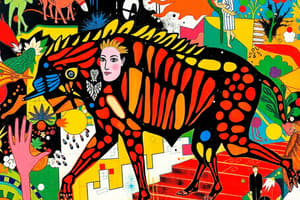Podcast
Questions and Answers
What is evolutionary adaptation?
What is evolutionary adaptation?
- An adaptation that increases competition
- Will survive and reproduce, driven by the environment (correct)
- A trait that cannot be inherited
- A trait that is randomly generated
Whether or not a trait is adaptive depends on the environment the organism finds itself in.
Whether or not a trait is adaptive depends on the environment the organism finds itself in.
True (A)
What are the three types of adaptations?
What are the three types of adaptations?
Morphological, physiological, behavioral
What is acclimation?
What is acclimation?
Give an example of acclimation.
Give an example of acclimation.
What is the function of the boundary layer?
What is the function of the boundary layer?
What does a common garden experiment seek to determine?
What does a common garden experiment seek to determine?
What is convergent evolution?
What is convergent evolution?
Can all traits be considered adaptations?
Can all traits be considered adaptations?
What are the two themes related to adaptations discussed?
What are the two themes related to adaptations discussed?
Why do giraffes have long necks?
Why do giraffes have long necks?
How do male giraffes compete for dominance?
How do male giraffes compete for dominance?
What is a trade-off in the context of adaptations?
What is a trade-off in the context of adaptations?
Flashcards are hidden until you start studying
Study Notes
Evolutionary Adaptation
- Evolutionary adaptation enhances an organism's ability to survive and reproduce, heavily influenced by environmental factors.
- Must be heritable to evolve and increase overall fitness.
Trait Adaptiveness
- The adaptability of a trait is contingent upon the environment in which the organism exists.
Types of Adaptation
- Adaptations can be morphological, physiological, or behavioral, all interconnected and shaped by natural selection.
- The development of one adaptation can lead to enhancement in others, like mutations affecting physiology and behavior.
Acclimation
- Acclimation is an environmentally induced physiological change in organisms, also referred to as phenotypic plasticity.
Example of Acclimation: Arctic Fox
- Arctic foxes demonstrate acclimation by developing thick fur and accumulating fat for insulation in cold weather.
- Exhibits seasonal changes like fur color and behavioral adaptations, such as caching food and curling up to conserve heat.
Acclimation in Foxes
- Foxes show acclimation over their lifetime, adjusting phenotype in response to environmental changes, which serves as an adaptive trait.
Wooly Lousewort Adaptation
- This plant possesses a thick layer of hair that traps air, maintaining a temperature advantage of 34°F to support cell division in cold conditions, providing a competitive edge.
Boundary Layer Concept
- The boundary layer is a thin layer of stagnant air or water that reduces the effects of wind or other disturbances surrounding an organism.
Common Garden Experiment
- The experiment assesses acclimation versus adaptation by utilizing clones with minimal genetic variation while varying environmental conditions such as temperature.
Convergent Evolution
- Similar environmental conditions can result in organisms developing analogous traits, showcasing how traits converge due to similar ecological pressures.
Convergent Evolution Examples
- Cacti and euphorbs, despite lacking common ancestry, have evolved similar adaptations to survive desert environments, such as a waxy cuticle and photosynthetic stems.
- The platypus, which is phlogenetically distant, has evolved electro-receptors in its bill for better prey detection.
Trait Adaptation Debate
- Not all traits are clearly classified as adaptations; evaluation focuses on whether they contribute to survival and reproduction, necessitating empirical testing.
Key Themes in Class
- Two central themes include limited resources and trade-offs in evolutionary adaptations.
Giraffe Adaptations
- Long necks in giraffes are traditionally thought to allow access to tree tops; however, during droughts, they also consume lower bushes.
- Seasonally, they exhibit feeding behavior variation based on food competition levels.
Giraffe Mating and Trait Expression
- Male giraffes compete for dominance, with those possessing longer necks gaining better access to females and producing more offspring.
- This trait becomes expressed in female giraffes as well, maintaining its classification as an adaptation.
Trade-offs in Adaptations
- Adaptation can lead to beneficial traits but may come with trade-offs; for instance, giraffes risk vulnerability to predation when drinking due to their unique body positioning.
Studying That Suits You
Use AI to generate personalized quizzes and flashcards to suit your learning preferences.



